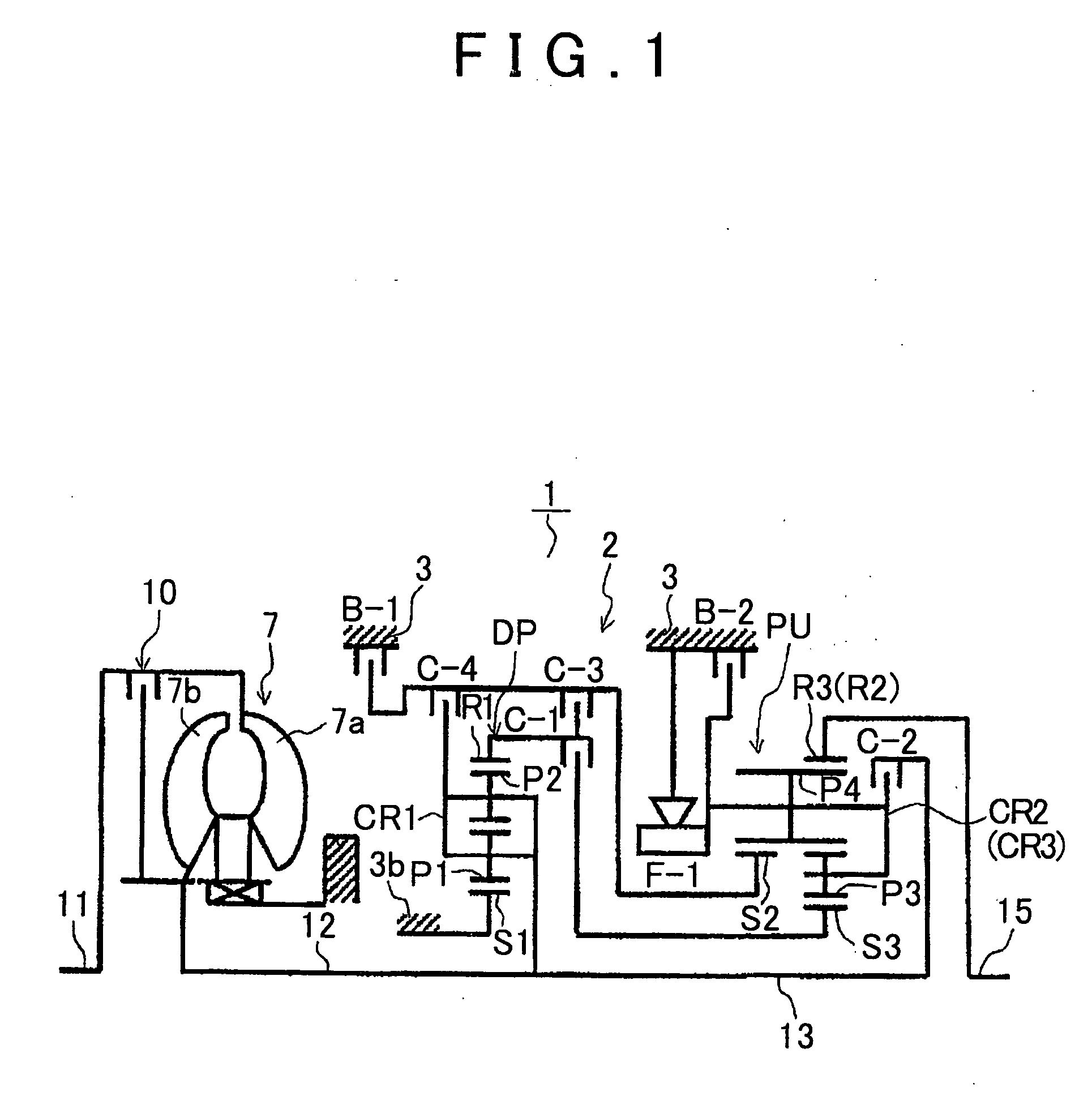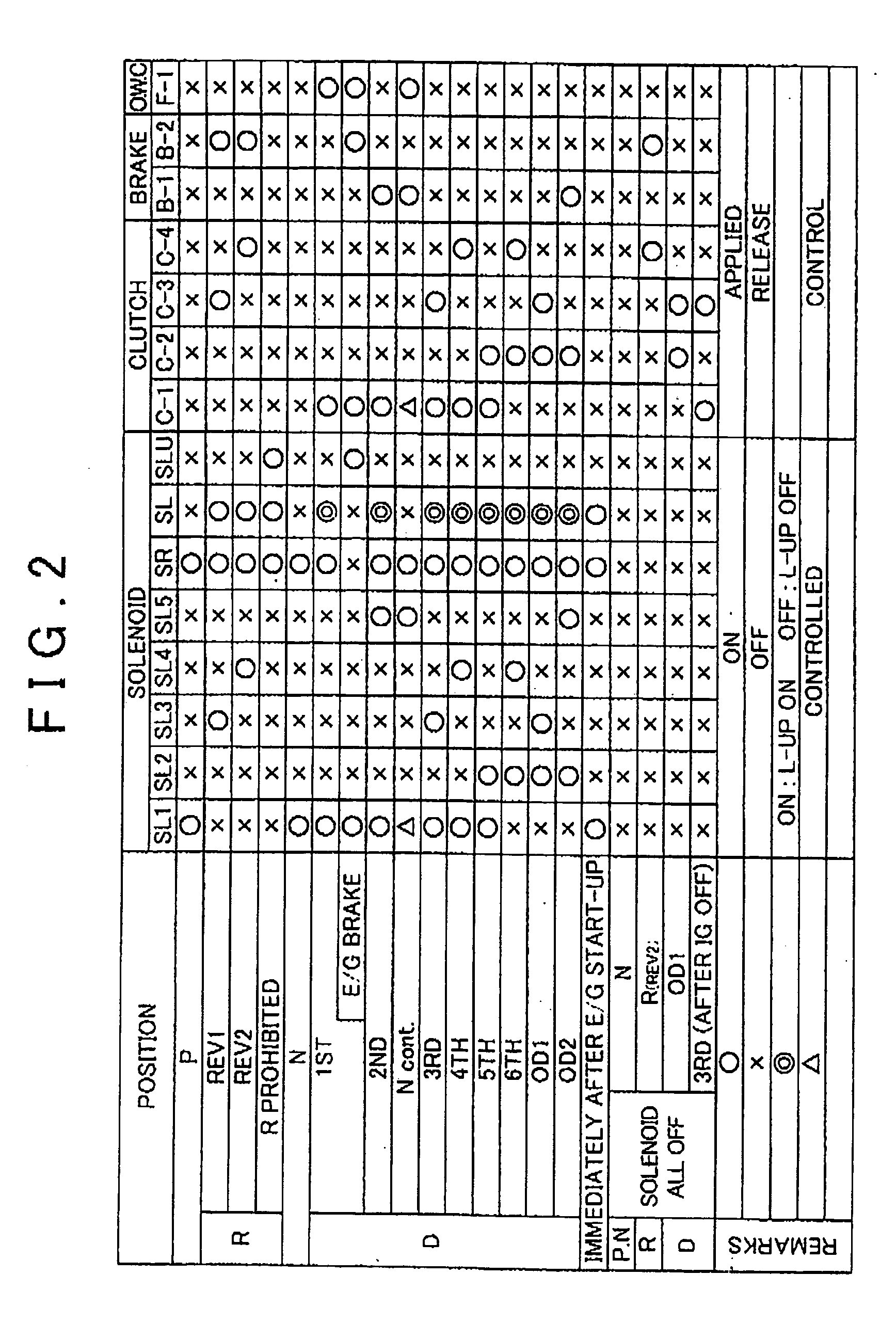[0010] According to the first aspect of the invention, during a failure in which all of the solenoid valves are de-energized, the first switching valve outputs a forward range pressure as a reverse input pressure, the second switching valve, which is locked at the second position due to the lock pressure, supplies an engagement pressure to the second hydraulic
servo by inputting the reverse input pressure to the
discharge port of the second engagement
pressure control solenoid valve, and the second switching valve, which is set at the first position by interrupting the lock pressure after restarting the engine, supplies an engagement pressure to the first hydraulic
servo by inputting a reverse input pressure to the discharge port of the first engagement
pressure control solenoid valve. Therefore, while the vehicle is traveling, it is possible to lock the shift speed at a relatively high speed. In addition, while the
downshifting of two or more speeds can be prevented, by restarting the engine, for example, after temporarily stopping the vehicle, it is possible to set the shift speed at a relatively
low speed, and it is possible to enable restarting of the vehicle.
[0011] According to the second aspect of the invention, because the second switching valve feeds line pressure to serve as lock pressure when at the second position, during the normal engine start-up, it is possible to lock the shift speed at the second position based on the line pressure. Thus, while the vehicle is traveling, it is possible to lock the shift speed at a relatively high speed even during a failure in which all of the solenoid valves are de-energized. In addition, by stopping the engine, the locking of the second switching valve is released based on the line pressure and the second switching valve can be set at the first position that interrupts the line pressure. Thus, by restarting the engine, it is possible to set the shift speed at a relatively
low speed and it is possible to enable restarting of the vehicle.
[0012] According to the third aspect of the invention, a fail
solenoid valve is provided that outputs a
signal pressure during a de-energized state and interrupts the
signal pressure after reverting to the energized state at least during a normal engine start-up. The second switching valve inputs the
signal pressure of the fail solenoid valve before being locked by the lock pressure during a failure in which all of the solenoid valves are de-energized and is switched to the first position due to this signal pressure. Therefore, by restarting the engine, it is possible to set the shift speed at a relatively
low speed.
[0016] According to the seventh aspect of the invention, the second spool of the second switching valve is set to the second position by abutting the second spool to the third spool when the third spool of the third switching valve is at the urging position. Therefore, even when, for example, a state occurs in which the third spool of the third switching valve sticks and the lock pressure is not communicated to the second switching valve, it is possible to maintain the second spool at the second position due to the
abutment of the third spool. Thereby, even when, for example, the third spool sticks, it is possible to prevent the second spool from being set at the first position, at which an engagement pressure is supplied to the first hydraulic
server. In addition, even during a failure in which all of the solenoid valves are de-energized while the vehicle is traveling, it is possible to reliably lock the shift speed at a relatively high speed and it is possible to reliably prevent the downshifting of two or more speeds from occurring.
[0018] According to the ninth aspect of the invention, the first switching valve outputs a reverse input pressure directly to a discharge port of the third engagement
pressure control solenoid valve during a failure in which all of the solenoid valves are de-energized and supplies an engagement pressure to the third hydraulic
servo that engages and disengages the friction engagement elements that engage at a relatively low speed and a relatively high speed. Therefore, it is possible to enable establishing a relatively low speed and a relatively high speed.
[0019] According to the tenth aspect of the invention, the fourth engagement pressure control solenoid valve inputs a lock pressure to an input port via the second switching valve as a line pressure. Therefore, before all of the solenoid valves become de-energized, it is possible to determine whether or not the first switching valve feeds the lock pressure normally depending on whether or not the shift speed that is established normally by the friction engagement element engaged by the fourth hydraulic servo has been attained. Thereby, for example, in the case in which the first switching valve is not locked by the lock pressure, all of the solenoids are set to be de-energized, and it is possible to prevent the occurrence of unintended downshifting and thereby ensure safe travel of the vehicle.
 Login to View More
Login to View More  Login to View More
Login to View More 


